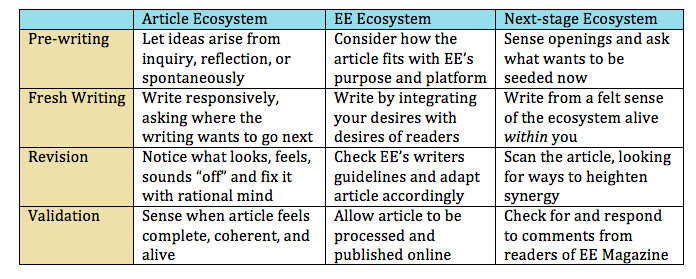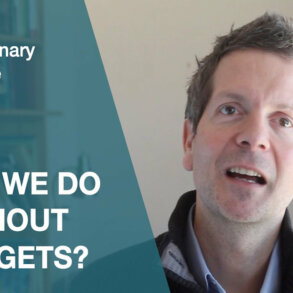By Edith Friesen for Enlivening Edge Magazine
I love patterns. So when I came across Tim Winton’s PatternDynamics™ cards a few years ago, I was in ecstasy. There I sat, day after day, cards spread out before me. I wanted to absorb the images, words, and relationships intuitively, to see and feel how they might apply to writing. Recently, I did the same with permaculture design principles developed by Bill Mollison and David Holmgren.
In keeping with my own patterns, I let the material foment in dark loam beneath my thinking mind. I trusted that something would eventually make its way into the light of day, into my focal awareness. I trusted that the timing would be perfect. This morning, in the liminal mist between sleeping and waking, an image of three interdependent, living ecosystems emerged.
Intersection of ecosystems and writing process
The largest of these is the ecosystem of next-stage tribes, organizations, and alliances. It grows more self-aware and inter-connective through articles in EE Magazine. The magazine, both part of the larger ecosystem and an ecosystem in itself, creates synergies by storing, flowing, and exchanging information. Each article is also a living ecosystem, a nested arrangement of symbols, meanings, and energies.
As I write this, I am beginning to see the interconnections between these living ecosystems and also how each plays into the writing process. I understand writing as a mostly non-linear process with four unique elements: pre-writing, fresh writing, revision, and validation. We could think of it as matrix with injunctions like these, a matrix where you jump around responsively, with dancer-like agility.

Attuned to the article ecosystem
My awareness of an article’s ecosystem is quite keen. Ideas arise spontaneously or ping off what I hear and read. During fresh writing, I drop beneath my thinking mind and write feeling-first, energy-first, heart-first. I continually ask the writing where it wants to flow next. When revising, I notice what looks, feels, and sounds “off,” and then I fix it, head-first. Validation comes when an article feels coherent and alive.
So, when the image of the three ecosystems emerged, I stayed with that feeling of wonder, grabbed my laptop, and began writing “This morning, in the liminal mist…” Then I continued writing in a responsive way, listening and feeling my way through the writing. While revising, I floated above the text and engaged my rational mind. When it seemed complete, I sent it off to EE Magazine’s copy editor.
Aligned with EE Magazine ecosystem
The EE Magazine ecosystem also enters my awareness during pre-writing. First I inquire: how does this article fit within EE’s platform and purpose? During fresh writing, I integrate what I want to contribute with what may feed our readers. When revising, I refer to EE Magazine’s Writer’s Guidelines and adapt my draft accordingly. Validation occurs when my article is published online.
Before writing this article, EE’s intention to strengthen the ecosystem of next-stage movements played softly in the background. While writing, I was energized by my love of creating new models and my passion for helping writers. EE Magazine’s copy editor requested diagrams and examples so I incorporated those. Then I waited for the process to take its course and for the publish button to be pushed.
Alive to the next-stage ecosystem
My awareness of the next-stage ecosystem is strong during pre-writing. I may sense openings. Or I may feel into that ecosystem and ask: what wants to be seeded now? During fresh writing, I relax and widen my awareness until I recede and the ecosystem comes alive within me. At revision, I scan my writing, looking for ways make more connections. Validation comes when EE Magazine readers comment on my article.
I often sense a hunger for what I call next-stage writing within the next-stage ecosystem. This is the hunger that Laloux fed with Reinventing Organizations. While writing this article, I tapped into the desire of next-stage organizations to meet and recognize each other through clear, heartfelt, and purpose-driven language.
As I revised, I imagined lights flickering on. Validation depends on you.
Shifting awareness
Sometimes, I am aware of one ecosystem more so than the others. Although one may rise to the top, the rest continue percolating underneath. They mingle and mix, ready to bubble to the surface at a moment’s notice and catch my attention. In this way, my awareness shifts organically among the three ecosystems, and also among parts of the writing process.
The more I practice bringing my awareness to each ecosystem, the more I inhabit it and it inhabits me. Eventually, the act of writing becomes effortless, selfless, and timeless. Sometimes, I go so deep that awareness just drops away—and there is only the writing.
This is how I understand ecosystem awareness today, and how it relates to my writing process. Tomorrow, new images, models, or languages could fall into my hands, and then something could change. In the meantime, I’d love to hear what ecosystem awareness means to you, and how that informs and inspires your writing process.

Edith Friesen energizes the role of Writing Mentor at Enlivening Edge. As a lifelong writer, she has worked in diverse organizations and coached writers. Her passion is to inspire writing that drops the mask and comes from the whole self. Send your email to [email protected], about joining the Teal-inspired global writing community.





For you and others who love patterns, i encourage you to check out the deck Group Works: A Pattern Language for Bringing Life to Meetings and Other Gatherings. Available for free download at http://www.groupworksdeck.org (translations also available in Spanish, French, & German).
Recently i have started thinking about what a pattern language for teal organizations would look like, and realized some noticeable portion of patterns would overlap with the Group Works set. Anyone who wants to explore that further please get in touch. Cheers!
.I like how you made those different ecosystems explicit. I hadn’t made that conscious. Tthank you Edith!
A quick thought that the next-stage Ecosystem (or Field) is a GOLD MINE for writers because it’s bursting with new connections and important things to “download.”. Even for those who haven’t considered themselves writers there’s no end of new stuff to say. I used to think that all the important stuff was already said by someone but it turns out, to my surprise, that there’s more to say than ever. And it’s important that it get said. Evolution is hiring writers big time!
I think you are onto something, Andrew. I witnessed that burst of connections last week at a writing workshop I facilitated in London. I was blown away by the emergence of powerful voices in service to the whole and to things that really matter.
We’re everywhere! 🙂